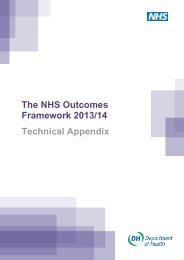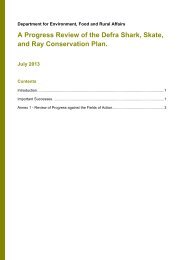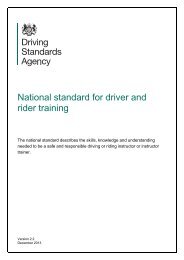Decontamination in primary care dental practices - Gov.uk
Decontamination in primary care dental practices - Gov.uk
Decontamination in primary care dental practices - Gov.uk
Create successful ePaper yourself
Turn your PDF publications into a flip-book with our unique Google optimized e-Paper software.
<strong>Decontam<strong>in</strong>ation</strong>: Health Technical Memorandum 01-05 – <strong>Decontam<strong>in</strong>ation</strong> <strong>in</strong> <strong>primary</strong> <strong>care</strong> <strong>dental</strong> <strong>practices</strong> (2013 edition)2.15 The re-use of a s<strong>in</strong>gle-use device has implicationsunder the Medical Devices Regulations. Anyonewho reprocesses or re-uses a device CE-marked foruse on a s<strong>in</strong>gle occasion bears the responsibilitiesnormally carried by the manufacturer for the safetyand effectiveness of the <strong>in</strong>strument.2.16 Shown below is the symbol that identifies s<strong>in</strong>gleuseitems. This will appear on packag<strong>in</strong>g but mightnot be present on <strong>in</strong>dividual items. If <strong>in</strong> doubt,further advice should be sought from themanufacturer.22.17 Where <strong>in</strong>struments are difficult to clean,consideration should be given to replac<strong>in</strong>g themwith s<strong>in</strong>gle-use <strong>in</strong>struments where possible. Indentistry this will <strong>in</strong>clude, but is not limited to,<strong>in</strong>struments such as matrix bands, saliva ejectors,aspirator tips and three-<strong>in</strong>-one tips.2.18 Where endodontic reamers and files are designatedreusable, they should be treated as s<strong>in</strong>gle patientuse or s<strong>in</strong>gle use – regardless of the manufacturer’sdesignation – to reduce the risk of priontransmission. Practices must have effectiveprocedures <strong>in</strong> place to exclude errors <strong>in</strong> identify<strong>in</strong>gthe <strong>in</strong>strument(s) and associat<strong>in</strong>g them with thecorrect patient.2.19 Care needs to be exercised <strong>in</strong> the clean<strong>in</strong>g of reusableendodontic reamers and files. Whereautomated washer–dis<strong>in</strong>fectors are used, the risk ofcross-contam<strong>in</strong>ation to other <strong>in</strong>struments would bevery low, <strong>in</strong> view of the dilution factors. These<strong>in</strong>struments do not need to be processed on aseparate cycle. However, ow<strong>in</strong>g to the variability <strong>in</strong>dilution dur<strong>in</strong>g manual wash<strong>in</strong>g, the files/reamersshould be washed separately from other<strong>in</strong>struments.Quality assurance system and audit2.20 Dental <strong>practices</strong> are required to establish andoperate a quality assurance system that covers theuse of effective measures of decontam<strong>in</strong>ation and<strong>in</strong>fection control. This may best be demonstratedby undertak<strong>in</strong>g audits and assessments of their<strong>in</strong>fection control and decontam<strong>in</strong>ation <strong>practices</strong>.These audits should be filed for <strong>in</strong>spection as partof their risk management system.2.21 Compliance with this Health TechnicalMemorandum will be seen as <strong>in</strong>dicative of thepresence of valid quality assurance systems. At am<strong>in</strong>imum, <strong>practices</strong> should audit theirdecontam<strong>in</strong>ation processes every six months, withan appropriate review dependent on auditoutcomes.NoteThe Infection Prevention Society/DH audit toolparallels the guidance provided <strong>in</strong> this document. Inaddition, a number of other safety-related topics are<strong>in</strong>cluded <strong>in</strong> the tool. See paragraph 1.7.2.22 It is important that the audits are made available toregulatory bodies for <strong>in</strong>spection when required.2.23 Audit documents should be stored for at least twoyears. They should not be removed from thepremises or destroyed.Tak<strong>in</strong>g <strong>in</strong>struments to other locations2.24 The practice should have safe procedures for thetransfer of contam<strong>in</strong>ated items from the treatmentarea to the decontam<strong>in</strong>ation facility.2.25 Transport conta<strong>in</strong>ers should be such as to protectboth the product dur<strong>in</strong>g transit and the handlerfrom <strong>in</strong>advertent contam<strong>in</strong>ation, and thereforeshould be:• leak-proof;• easy to clean;• rigid, to conta<strong>in</strong> <strong>in</strong>struments, prevent<strong>in</strong>g thembecom<strong>in</strong>g a sharps hazard to anyone handl<strong>in</strong>gthe goods and to protect them aga<strong>in</strong>st acci<strong>dental</strong>damage;• capable of be<strong>in</strong>g closed securely;• robust enough to prevent <strong>in</strong>struments be<strong>in</strong>gdamaged <strong>in</strong> transit.14
















